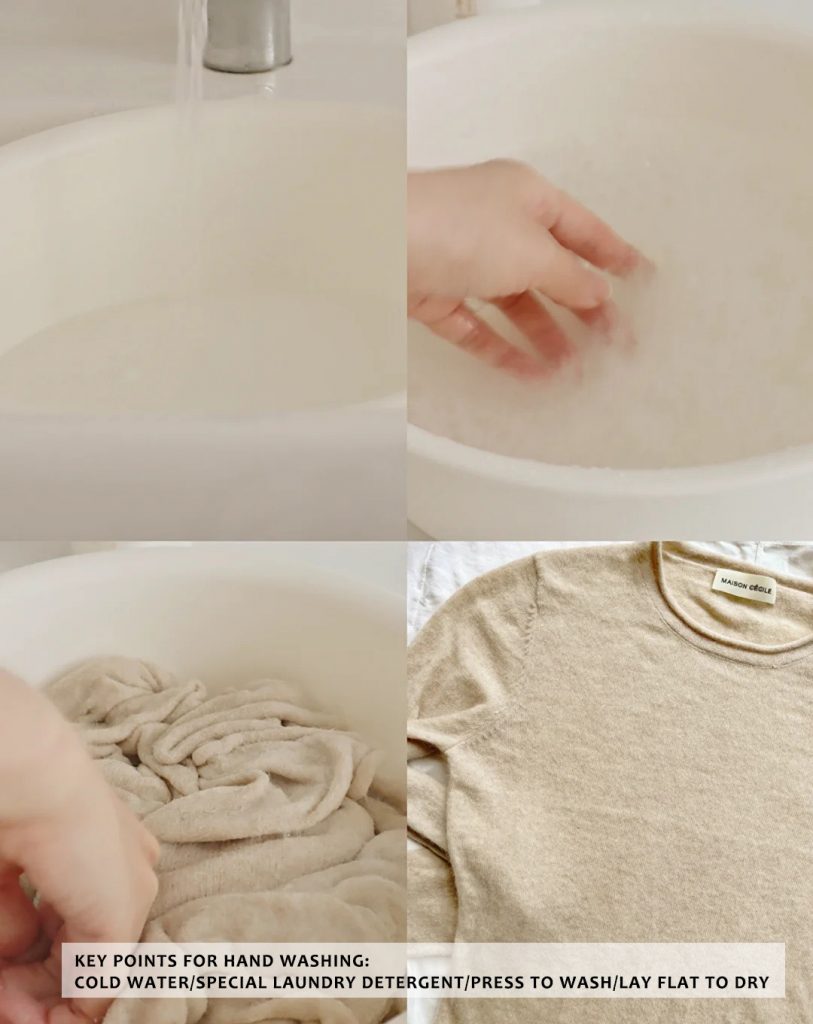The popular style of wool vests has returned to the fashion world, combining functionality, style, and comfort. Whether you’re wearing the shirt over a crisp white coat for a classic look or pairing it with jeans for a casual appearance, a wool vest that is bothersome can augment any attire. However, in order to ensure your cherished clothing will last for the seasons to come, proper treatment is crucial.
In this comprehensive article, we’ll discuss the intricacies of taking care of your wool sweater vest. From understanding the different types of wool to mastering the removal of stains and storage techniques, we’ll share with you expert advice regarding how to maintain your sweater’s appearance.
Ⅰ、Understanding the Wool: A More In-depth Examination
Wool, a natural fiber derived from animal’s hair, is renowned for its temperature regulation, resilience, and breathability.. These attributes make it a great choice for vests that are sweaters, they provide warmth and fashion throughout the cold months. However, not all wool is created with the same amount of care. To take care of your wool sweater vest properly, you must understand the different types of wool and their unique attributes.
While there are numerous different types of wool across the world, here are a few of the most common types employed in vests with sweaters.
- Merino wool: it’s renowned for its exceptional softness, fine fibers, and moisture-wicking abilities, these properties make it a popular choice for vests with sweaters. It’s capable of regulating the temperature to a high degree, which is beneficial for various climates.
- Cashmereis considered the embodiment of luxury, it’s incroyably luxurious, and invokes a warmth. Cashmere sweaters are cherished items that need special attention.
- Lambswool: Derived from the first cutting of a lamb, Lambswool is more flabby than the wool of adult sheep. It’s effective at insulation and is typically used in more budget-friendly sweaters.
- Alpaca wool: Originating from South America, alpaca wool is well-known for its softness, warmth, and hypoallergenic properties. It’s a popular alternative to cashmere.
- The Scottish Shetland Woolis derived from the Shetland Islands, it is renowned for its longevity, strength, and water-resistant nature. Shetland wool sweaters are beneficial for temperate climates.
- Merino wool: This specific type is dedicated to the exceptional quality and consistency of the wool produced in Australia; it is, therefore, popular for use in sweaters.
You can learn more from my previous blog: How to Find the Right Wool for Men’s Knitwear
To figure out what kind of wool you have in your vest with care, check the label of care. It must reveal the amount of fibre present. If the label is missing or mislabeled, you can specifically examine the fabric. Cashmere and Merino wool are more refined and lighter than lambswool or alpaca wool.
Understanding the specific type of wool in your sweater is crucial to determining the appropriate methods of treatment. Different types of wool have different responses to water, heat and detergents. By understanding the makeup of your clothing, you can take steps to maintain its quality and length.
Ⅱ、Washing Your Wool Sweater Vest

The old saying that never cleans wool has been contradicted. While it’s acknowledged that wool is delicate, with proper treatment, you can maintain the hygienic and fresh nature of your sweater. Let’s discuss the most effective methods of cleaning your wool’s beauty.
1. Washing Your Wool Sweater in Hand
For the majority of wool sweaters, it’s recommended that you hand wash them in order to maintain their quality. Here is a procedure-by-procedure explanation:
- Warm water: Avoid hot water as it will cause shrinkage.
- Add a mild detergent for wool: Look for a detergent that is specifically designed to be used on delicate wool. Avoid ordinary detergent for the laundry.
- Submerge the sweater vest: Gently soak the sweater vest in water with detergent, do not rub it hard. Just press it gently.
- Rinse the sweater vest thoroughly: Rinse the vest in warm water until all of the soap is removed.
- Squeaky the extra water out of the sweater: Avoid pulling or twisting the vest.
2. Machine Washing Your Wool Sweater Vest
While hand washing is generally preferred, some modern wool blends might have a care label indicating machine washing is acceptable. Always prioritize the care label instructions. If machine washing is permitted, use a gentle cycle and a wool-specific detergent.
Ⅲ、Drying Your Wool Sweater Vest
The proper drying of your wool sweater is crucial to preventing shrinkage, maintaining its shape, and maintaining its softness. Here are some important guidelines:

Air Dried Your wool sweater?
- Flat-it: The most common method of drying a wool vest with a sweater is to lay it flat on a clean, dry towel. This facilitates the prevention of stretchiness and distortion.
- Avoid wringing: Extra water will adversely affect the wool’s fibers. Instead, gently squeeze out the excess water.
- Reshape: Recreate the original design of the sweater vest while it’s damp. This will aid in maintaining its original shape as it is dried.
- Avoid direct sunlight: Direct sunlight can adversely affect the wool’s fibers and lead to their depletion. Decide on a shaded area or room with indirect lighting.
- Patience is crucial: Allow the sweater vest to dry completely before wearing it. Rushing the drying process can lead to issues.
- Select a dependable rack: Ensure the drying rack is sturdy and large enough to Flat a sweater vest without it stretching.
- Even distribution: Lay the sweater vest across the drying area, making sure it is equally spread out in order to avoid sagging.
2. Dryer Use (If Permitted)
While air drying is typically employed, some modern wool combinations may be appropriate for dryer use. always check the label of care for specific rules.
- Low heat: If the machine is permitted to dry, utilize a low temperature setting.
- Wool dryer balls: These can facilitate the fluffing of wool and reduce the amount of time needed to dry it.
- Quick cycle: Opte for a brief drying cycle that will minimize the likelihood of shrinkage or damage.
Remember: Even if your sweater vest is said to be machine-washable, air-drying is often the safest and most effective method of maintaining its quality.
Ⅳ、Stain Removal: Tackling Troublespots
Accidents happen, and stains are a despised adversary to your cherished wool vest. However, the proper method can effectively remove many stains without negatively impacting the delicate fabric.

⒈ Common Stains and Their Treatment
- Coffee or Tea: Immediately blot the stain with a fresh, absorbent cloth. Avoid touching, as this can lead to the stain spreading. Create a mixture of one part white vinegar to two parts water, apply it to the stain, and let it sit for a few minutes before gently blotting. Soak in the cold water.
- Red Wine: Action is necessary! Absorb the stain with a fresh, dry cloth in order to maximize the amount of wine that is absorbed. Create a mixture of one part white vinegar to two parts water, apply it to the stain, and let it sit for a few minutes before gently blotting. Soak in the cold water.
- Grease or Oil: Over the stain, sprinkle cornstarch or baking soda to soak up the oil. Allow it to sit for several hours before cleaning the powder. gently wash the sweater vest with a special detergent for wool..
- Ink: Spot the ink mark with a fresh, dry cloth. Avoid touching. Test a small, imperceptible portion of the sweater vest with a stain remover that is specifically designed for wool before applying it to the stain. Pay attention to the product’s instructions specifically
⒉ General Stain Removal Tips
- Act swiftly: The more quickly you address a stain, the greater your probability of successfully removing it.
- Blot, don’t scrape: Scraping can spread the stain and adversely affect the wool’s fibers.
- Test the stain removal: Always test any stain remover on a small, imperceptible portion of the sweater before applying it to the stain.
- Professional treatment: For difficult stains or delicate wool blends, consider bringing your sweater to a professional cleaner that specializes in wool clothing.
Ⅴ、Storage: Protecting Your Investment
Effective storage is pivotal in maintaining the quality and length of your wool sweater vest. By following these suggestions, you can safeguard your clothing and ensure that your sweater will remain in top condition for the upcoming seasons.

⒈ Essential Storage Tips
- Before storing: Ensure your sweater vest is spotless and dry before storing it. Any stains or smells will become more noticeable over time.
- Select the proper location: Select a cool, dark, and dry space for storage. Avoid areas with high moisture, this will adversely affect the wool’s fibers.
- Prevent damage from pests: Moths and other pests can cause havoc on wool. Consider using cedar blocks or lavender packets to combat these unwanted visitors.
- Folding or hanging: The most effective method of storage is based on the type of sweater vest you have. Bulky styles are often best folded, while slimmer vests can be hung.
⒉ Folding Your Wool Sweater Vest
- Flat it: Lay the sweater vest down, then fold the vest in half lengthwise, then in half again..
- Utilize tissue paper: Use tissue paper between the folds to prevent folding and maintain the sweater’s original shape.
- Storage container: Store the folded sweater vest in a breathable fabric bag or a cedar chest.
⒊ Hanging Your Wool Sweater Vest
- Wide hangers: Use wide, padded hangers to prevent shoulder bumps and maintain the sweater’s shape.
- Cover it up: Consider using a garment bag to protect the sweater from dust and light.
Ⅵ、Professional Cleaning: When to Seek Expert Help
While you can take care of your wool vest at home, there are times when professional cleaning is necessary. Here is when it’s appropriate to seek professional help:
- Intricate details: If your sweater vest has intricate decorations, beading, or needlework, professional cleaning is necessary to prevent damage.
- Stubborn stains: If you’ve attempted multiple remedies at home without success, a professional cleaner may be able to remove the stain.
- Heavy use and tearing: Over time, wool’s fibers can become compacted or lose their original shape. Professional cleaning can mend your sweater’s appearance.
- Allergens: If you’re allergic to something or have a sensitivity to it, professional cleaning can help you remove allergens from your wool sweater.
When selecting a professional cleaner, consider one that has experience dealing with delicate wool clothing.
Conclusion
Taking care of a wool vest that is both warm and fashionable may seem daunting, but with the proper knowledge and care, you can extend its life and enjoy its comfort and style for years to come. By understanding the different types of wool, following the proper washing and drying processes, and practicing responsible storage, you’ll maintain your investment and preserve the luxurious feel of your sweater.
Remember, prevention is essential. Regular audits, mild handling, and timely removal of stains can have a significant impact on the protection of your wool vest. While professional cleaning is necessary for specific instances, home care is often sufficient.
With a bit more care, your wool sweater vest will become a cherished possession in your Wardrobe, providing comfort and fashion every season.




